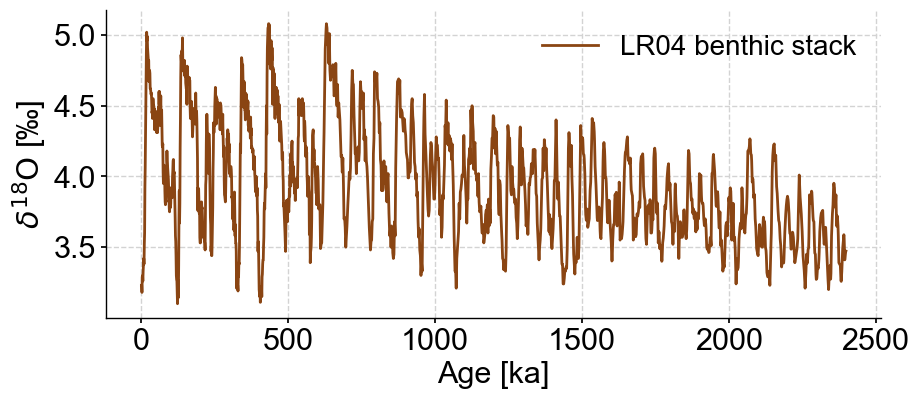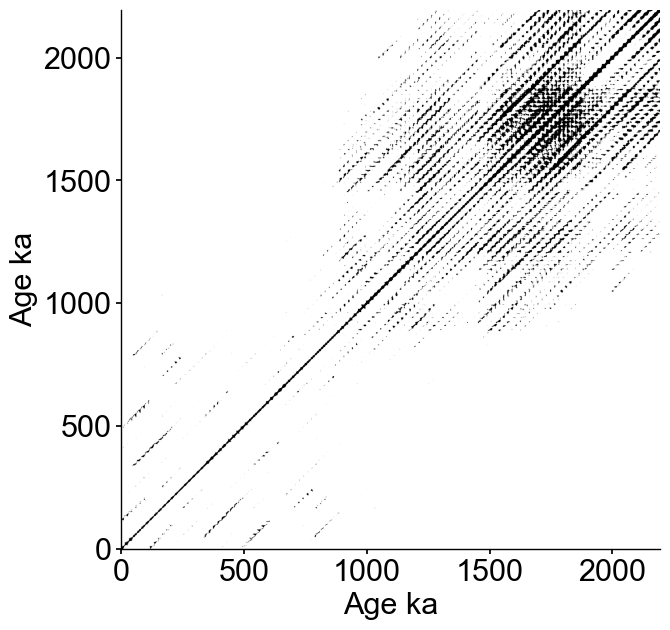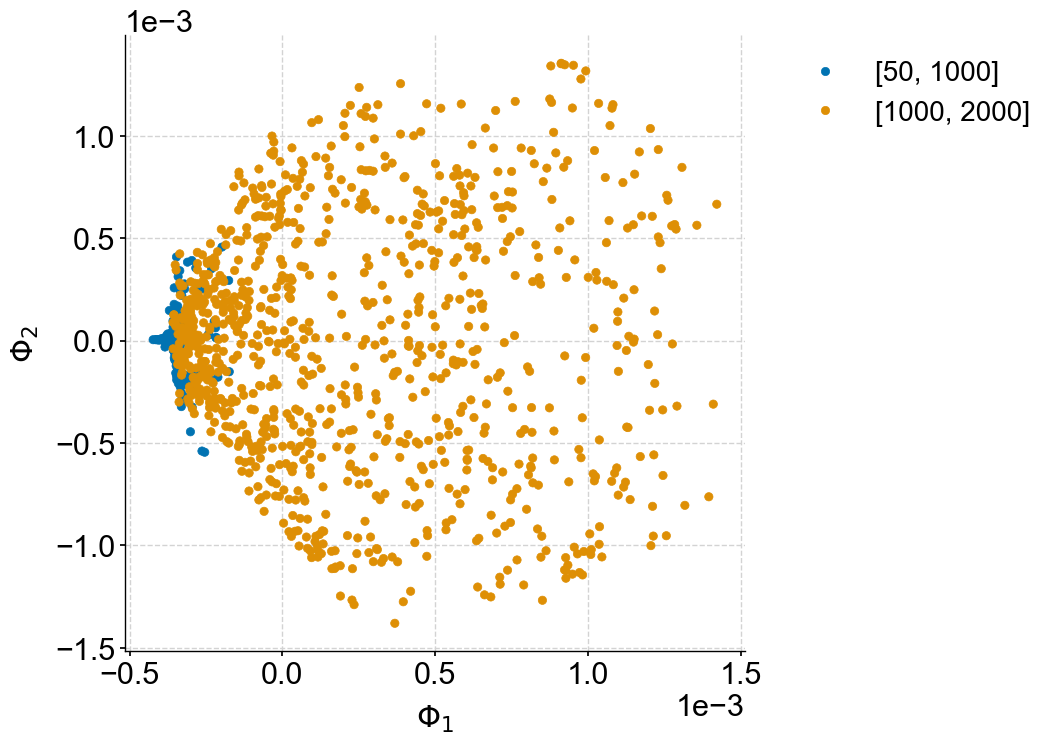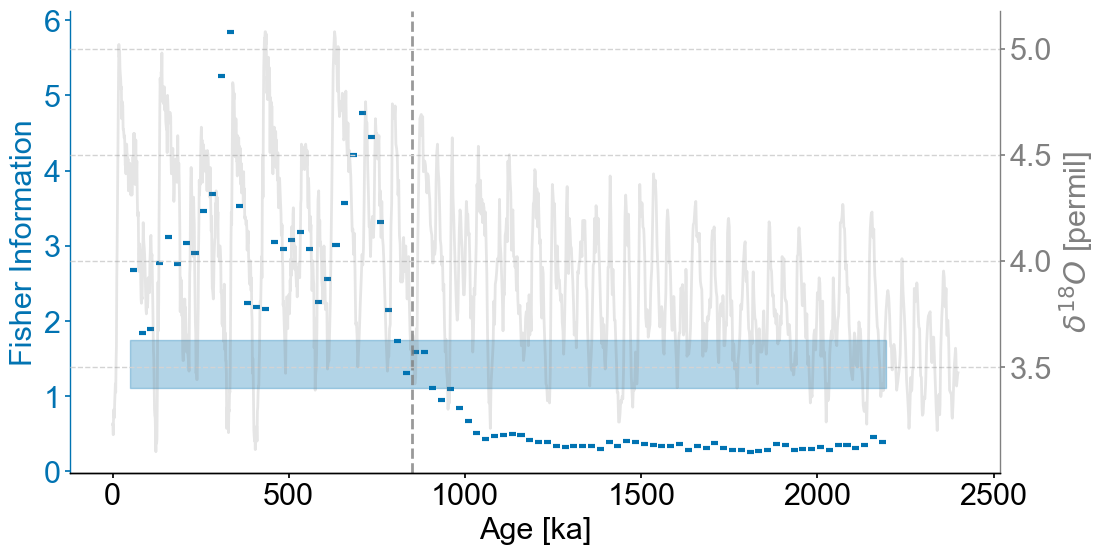Figure 1#
import pyleoclim as pyleo
import matplotlib.pyplot as plt
from matplotlib import gridspec
import matplotlib.transforms as transforms
import matplotlib.patches as mpatches
import seaborn as sns
import numpy as np
import ammonyte as amt
import pandas as pd
from tqdm import tqdm
from mpl_toolkits.mplot3d import Axes3D
from matplotlib.colors import ListedColormap
#We suppress warnings for these notebooks for presentation purposes. Best practice is to not do this though.
import warnings
warnings.filterwarnings('ignore')
Setting font sizes for the figures
SMALL_SIZE = 20
MEDIUM_SIZE = 22
BIGGER_SIZE = 26
plt.rc('font', size=SMALL_SIZE) # controls default text sizes
plt.rc('axes', titlesize=SMALL_SIZE) # fontsize of the axes title
plt.rc('axes', labelsize=MEDIUM_SIZE) # fontsize of the x and y labels
plt.rc('xtick', labelsize=MEDIUM_SIZE) # fontsize of the tick labels
plt.rc('ytick', labelsize=MEDIUM_SIZE) # fontsize of the tick labels
plt.rc('legend', fontsize=SMALL_SIZE) # legend fontsize
plt.rc('figure', titlesize=BIGGER_SIZE) # fontsize of the figure title
Using Pyleoclim to load the data we’ll be using for this example.
series = pyleo.utils.load_dataset('LR04').slice((0,2400))
time = series.time
series = series.interp(time_axis=np.arange(int(min(time)),int(max(time))))
fig, ax = series.plot(color='#8A4513')

Embedding with an embedding dimension m of 12 and tau selected according to the first minimum of mutual information, then calculating the recurrence plot. Targeting a recurrence density of 5% (this is the default).
td = amt.TimeEmbeddedSeries(series,m=12)
rm = td.find_epsilon(eps=1)['Output']
print(f'Tau is : {td.tau}')
Initial density is 0.0544
Initial density is within the tolerance window!
Tau is : 17
fig,ax = rm.plot(figsize=(7,7))
xticks = ax.get_xticks()
xlim = ax.get_xlim()
ax.set_yticks(xticks)
ax.set_ylim(xlim)
ax.set_title(None)
ax.grid(False)

Carrying out the Laplacian eigenmapping + Fisher information steps using a window size of 50 indices and a window increment of 5.
lp = rm.laplacian_eigenmaps(w_size=50,w_incre=5)
def plot_eigenmaps(self,groups,axes,figsize=(12,12),palette='colorblind',ax=None,title=None):
'''Function to display eigenmaps
Only works when the RQARes has been created via the laplacian eigenmaps function
Parameters
----------
groups : list,tuple; (start,stop)
List of lists or tuples containing start stop time indices for coloring. Should be ordered in time.
axes : list,tuple
Axes of the eigenvectors. Should be list or tuple of length 2.
figsize : list,tuple
Size of the figure
palette : str, list
Color map to use for color coding according to time. Can either be the name of a color map or a list of colors
ax : matplotlib.axes.Axes
Ax object to plot on.
Returns
-------
fig : matplotlib.figure
The figure object from matplotlib.
See `matplotlib.pyplot.figure <https://matplotlib.org/stable/api/figure_api.html>`_ for details.
ax : matplotlib.axis
The axis object from matplotlib.
See `matplotlib.axes <https://matplotlib.org/stable/api/axes_api.html>`_ for details.
'''
if not ax:
fig, ax = plt.subplots(figsize=figsize)
data_dict = {
'eig1' : [],
'eig2' : [],
'Group' : []
}
eigvec = self.eigenmap
for idx,group in enumerate(groups):
if not isinstance(group,(list,tuple)) or len(group) != 2:
raise ValueError(f'Group [{idx}] format is not recognized. Please use [(start,stop),(start,stop),etc.] format for groups.')
start = group[0]
stop = group[1]
if start > max(self.time) or start < min(self.time):
print('Start value exceed time bounds of RQARes object, ')
start = max(self.time)
if stop > max(self.time) or stop < min(self.time):
raise ValueError(f'Stop time [{stop}] from group [{idx}] is not within the time bounds of your RQARes object.')
start_index = np.where(self.series.time==start)[0][0]
stop_index = np.where(self.series.time==stop)[0][0]
eig1 = eigvec[:,axes[0]][start_index:stop_index]
eig2 = eigvec[:,axes[1]][start_index:stop_index]
labels = [f'{group}' for i in range(len(eig1))]
data_dict['eig1'].extend(eig1)
data_dict['eig2'].extend(eig2)
data_dict['Group'].extend(labels)
data = pd.DataFrame(data_dict)
sns.scatterplot(data=data,x='eig1',y='eig2',hue='Group',palette='colorblind',edgecolor=None)
if title is None:
title = f'Eigenmaps for {self.label}'
ax.set_title(title)
ax.set_xlabel(f'$\Phi_{axes[0]}$',labelpad=10)
ax.set_ylabel(f'$\Phi_{axes[1]}$',labelpad=10)
ax.ticklabel_format(axis='x', scilimits=[0, 0])
ax.ticklabel_format(axis='y', scilimits=[0, 0])
ax.legend(bbox_to_anchor=(1.5, 1), loc='upper right')
if 'fig' in locals():
return fig, ax
else:
return ax
def plot_eigenmaps_FI(self,groups,axes,palette='colorblind',figsize=(18,12),
FI_axis_lims=None,scale=(1,1,1),title=None):
'''Function to display eigenmaps as a function of fisher information
Only works when the RQARes has been created via the laplacian eigenmaps function
Parameters
----------
groups : list,tuple; (start,stop)
List of lists or tuples containing start stop time indices for block smoothing.
axes : list,tuple
Axes of the eigenvectors to plot against Fisher Information. Should be list or tuple of length 2.
palette : str
Color map to use for color coding according to time
figsize : list,tuple
Size of the figure
FI_axis_lims : list,tuple
Boundaries for the fisher information axis
Returns
-------
fig : matplotlib.figure
The figure object from matplotlib.
See `matplotlib.pyplot.figure <https://matplotlib.org/stable/api/figure_api.html>`_ for details.
ax : matplotlib.axis
The axis object from matplotlib.
See `matplotlib.axes <https://matplotlib.org/stable/api/axes_api.html>`_ for details.
'''
fig = plt.figure(figsize=figsize)
ax = Axes3D(fig, auto_add_to_figure=False)
fig.add_axes(ax)
cmap = sns.color_palette(palette,len(groups))
data_dict = {
'eig1' : [],
'eig2' : [],
'FI' : [],
'c' : []
}
eigvec = self.eigenmap
for idx,group in enumerate(groups):
if not isinstance(group,(list,tuple)) or len(group) != 2:
raise ValueError(f'Group [{idx}] format is not recognized. Please use [(start,stop),(start,stop),etc.] format for groups.')
start = group[0]
stop = group[1]
if start > max(self.time) or start < min(self.time):
print('Start value exceed time bounds of RQARes object, ')
start = max(self.time)
if stop > max(self.time) or stop < min(self.time):
raise ValueError(f'Stop time [{stop}] from group [{idx}] is not within the time bounds of your RQARes object.')
start_index = np.where(self.series.time==start)[0][0]
stop_index = np.where(self.series.time==stop)[0][0]
eig1 = eigvec[:,axes[0]][start_index:stop_index]
eig2 = eigvec[:,axes[1]][start_index:stop_index]
labels = [cmap[idx] for i in range(len(eig1))]
data_dict['eig1'].extend(eig1)
data_dict['eig2'].extend(eig2)
data_dict['c'].extend(labels)
rqa_slice = self.slice(group)
FI_block_value = np.mean(rqa_slice.value)
FI = np.full(len(eig1), FI_block_value)
data_dict['FI'].extend(FI)
data = pd.DataFrame(data_dict)
x = data['FI']
y = data['eig1']
z = data['eig2']
c = data['c']
if FI_axis_lims:
ax.set_xlim(left=min(FI_axis_lims),right=max(FI_axis_lims))
sc=ax.scatter(x,y,z,s=40, c=c, marker='o', alpha=1)
ax.set_xlabel('FI',labelpad=20,loc='center')
ax.set_ylabel(f'$\Phi_{axes[0]}$',labelpad=20,loc='center')
ax.set_zlabel(f'$\Phi_{axes[1]}$',labelpad=20)
ax.ticklabel_format(axis='x', scilimits=[0, 0])
ax.ticklabel_format(axis='y', scilimits=[0, 0])
ax.ticklabel_format(axis='z', scilimits=[0, 0])
ax.tick_params(axis='both', which='major', pad=10)
ax.set_title(title)
scale_x,scale_y,scale_z = scale
ax.get_proj = lambda: np.dot(Axes3D.get_proj(ax), np.diag([scale_x, scale_y, scale_z, 1]))
ax.legend(*sc.legend_elements(), bbox_to_anchor=(1.05, 1), loc=2)
if 'fig' in locals():
return fig, ax
else:
return ax
fig,ax = plot_eigenmaps(lp,groups=[[50,1000],[1000,2000]],axes=[1,2],figsize=(8,8))
ax.set_title(None)
Text(0.5, 1.0, '')

fig,ax=plot_eigenmaps_FI(lp,groups=[[50,1000],[1000,2000]],axes=[1,2],figsize=(8,8))

def detect_transitions(series,transition_interval=None):
'''Function to detect transitions across a confidence interval
Parameters
----------
series : pyleo.Series, amt.Series
Series to detect transitions upon
transition_interval : list,tuple
Upper and lower bound for the transition interval
Returns
-------
transitions : list
Timing of the transitions of the series across its confidence interval
'''
series_fine = series.interp(step=1)
if transition_interval is None:
upper, lower = amt.utils.sampling.confidence_interval(series)
else:
upper, lower = transition_interval
above_thresh = np.where(series_fine.value > upper,1,0)
below_thresh = np.where(series_fine.value < lower,1,0)
transition_above = np.diff(above_thresh)
transition_below = np.diff(below_thresh)
upper_trans = series_fine.time[1:][np.diff(above_thresh) != 0]
lower_trans = series_fine.time[1:][np.diff(below_thresh) != 0]
full_trans = np.zeros(len(transition_above))
last_above = 0
last_below = 0
for i in range(len(transition_above)):
above = transition_above[i]
below = transition_below[i]
if above != 0:
if last_below+above == 0:
loc = int((i+below_pointer)/2)
full_trans[loc] = 1
last_below=0
last_above = above
above_pointer = i
if below != 0:
if last_above + below == 0:
loc = int((i+above_pointer)/2)
full_trans[loc] = 1
last_above=0
last_below = below
below_pointer = i
transitions = series_fine.time[1:][full_trans != 0]
return transitions
color_list = sns.color_palette('colorblind')
lp_smooth = lp.smooth(block_size=5) #Binning the Fisher information into blocks with a given number of indices
upper, lower = amt.utils.sampling.confidence_interval(series=lp,upper=95,lower=5,w=50,n_samples=10000) #Finding upper and lower bounds for our transition interval
transitions=detect_transitions(lp_smooth,transition_interval=(upper,lower))
fig,ax = lp.confidence_smooth_plot(
background_series = series,
block_size=5,
color=color_list[0],
figsize=(12,6),
title='',
legend=True,
lgd_kwargs={'loc':'upper left'},
# hline_kwargs={'label':None},
background_kwargs={'ylabel':'$\delta^{18}O$ [permil]','legend':False})
ax.legend().set_visible(False)
ax.axvline(transitions[0],linestyle='dashed',color='grey',alpha=.8)
<matplotlib.lines.Line2D at 0x2a0614ee0>

